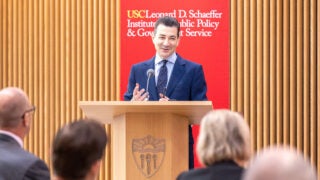USC conversation spotlights immigration policy, effect on families
California administrator’s book chronicles a series of political decisions and actions of ‘enormous consequences’
A day after the U.S. Supreme Court announced it would hear the case to determine the constitutionality of President Barack Obama’s executive actions on immigration, the USC Price School of Public Policy’s Tomás Rivera Policy Institute co-hosted a timely discussion with administrator Marjorie Zatz on her book Dreams and Nightmares: Immigration, Youth and Families.
The Jan. 20 conversation also featured TRPI director and USC Price Professor Roberto Suro and USC Gould School of Law Assistant Professor Emily Ryo. Three USC Price student organizations served as co-sponsors: the Price Latino Student Association, Partnership for an Equitable Los Angeles and Asian Pacific Islander Caucus.
Zatz, vice provost and graduate dean at the University of California, Merced, said she was convinced that comprehensive immigration reform was going to pass and make her book, published last year, out of date before it hit the bookshelves. Instead, she can’t see legislation passing until at least after the 2020 U.S. Census redistricting.
It’s right on the topic of the moment in a way that just doesn’t happen very often in this business.
Roberto Suro
“It’s an incredibly timely book,” Suro said. “It’s right on the topic of the moment in a way that just doesn’t happen very often in this business. It’s very well framed to focus attention on the issues that are going to be before the court. It’s a pioneering work in the sense that it’s talking about a series of political decisions and actions of enormous consequences.”
Setting the stage
Zatz set the stage with some basic numbers: 11.3 million unauthorized immigrants reside in the United States, two-thirds of whom have been in the country for more than a decade. There are 5.1 million children of unauthorized immigrants, with more than 4 million born in the U.S.
Dreams and Nightmares uses the experiences of children to provide a prism through which the interwoven dynamics and consequences of immigration policy become apparent. Zatz tells of children who didn’t know they were undocumented until they were teenagers and how this is like awakening into a nightmare.
President Obama has deported more than 2 million undocumented immigrants, the most of any U.S. president. As a result, many Latino voters — two-thirds of whom supported Obama in 2008 — lost trust in the president, according to Zatz.
Executive action
As the 2012 election approached, the Dreamers social movement pressured the president to introduce Deferred Action for Childhood Arrivals (DACA), an executive action that allowed undocumented immigrants who entered the country before their 16th birthday to receive a renewable two-year work permit and exemption from deportation.
Although the action provided some progress, Zatz and Suro believe it made the passage of comprehensive immigration reform more difficult by upsetting Republicans.
“Would comprehensive immigration reform have died anyway? Who knows,” Zatz said. “I do think DACA was political expediency. They needed to have the Latino vote for the 2012 election.”
The president has attempted to do more for immigrants in his second term, the speakers noted. Late in 2014, he announced an expansion of DACA to extend the deferral period to three years, remove the age limit and shield parents with a child who is a U.S. citizen or lawful permanent resident. Twenty-six states filed a lawsuit to get an injunction that stopped implementation.
Under review
Obama asked the Supreme Court to review the matter, and Zatz said the Court is expected to hear oral arguments in April and make a decision in June. In the meantime, the 2012 version of DACA is in place. But an executive order remains in place only as long as the president wants it to be policy — and Obama’s final term in office is coming to an end.
“I’m not sure anyone can really understand exactly how we got to those 2 million removals,” Suro said. “This book is the only place I have seen the history of Obama’s first term put together where one can see the chronology of how this proceeded. It’s a very powerful story that needs to be understood. It makes you understand the limitations of government and policy. It’s sobering for anyone in policy work because you wonder who’s in charge.”



